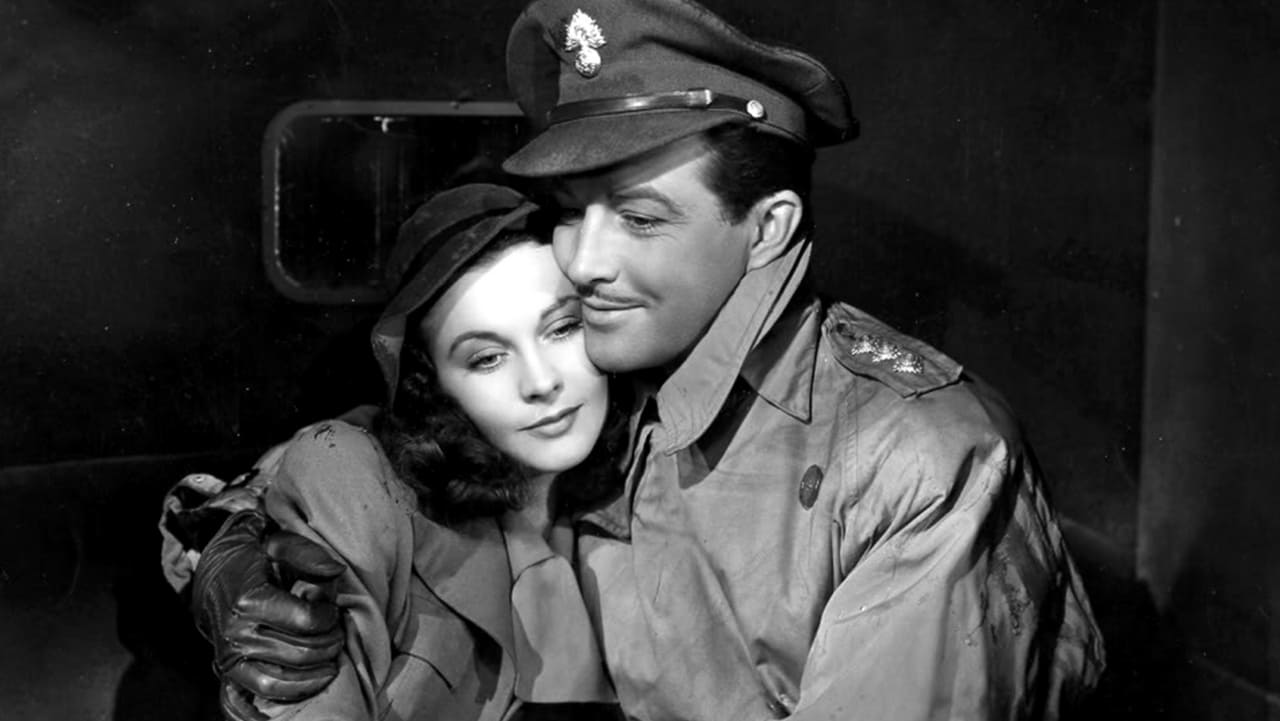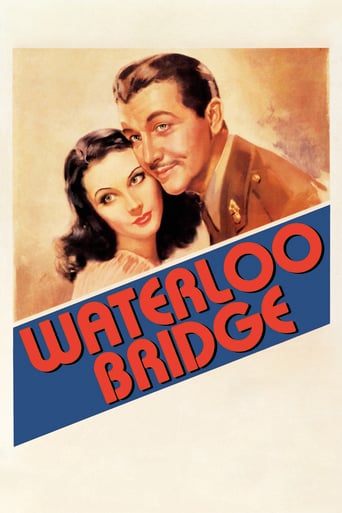

Mainly I wanted to know how Taylor found that lone lost suicide survivor, the kewpie doll. It had to have been crushed during cleanup of the accident scene but of course, he could have just purchased another good luck charm. This, among other non-sequitur questions, remain after viewing this film. Another, after reading of her fiancé's death in the paper, how could she contain her grief to Mama given that she was a dancer, NOT an actress! A simple search for her name would turn up a kid or two unless she had changed her name which most fallen women do, right? Hmmmm, doesn't make much sense to resort to this profession when so much help was available. Perhaps the unwritten script is that she secretly liked to dance naked for money? I was most impressed with how they aged Taylor over 20 plus years, a hint of baby powder on the mustache and voila! vs Leigh in "That Hamilton Woman" end scene.Despite the above mentioned issues, I really enjoyed the film immersed in it's many foibles. And, oh I forgot the dress code of the early 20th century in England, good thing Downton Abbey got it right! Have you ever fallen in love with such urgency and not just based on attraction alone? It is quite a spectacular moment in life and very rare indeed but occurs more in real life than on screen truth be told.Leigh never looked more ravishing in exquisite gowns, ballet attire, and close ups were her dearest ally. What a refreshing face, so expressive and eyes divine. Even Ol Blanche was positively lovely. A great loss to the film world with her limited productions.Be prepared for a tear jerker though, the many decisions in life that forced her to depart reality were reminiscent of that crazy unpredictable element named, Fate. Many feel they were irresponsible, rash decisions with little forethought but how easy it is to judge.High recommend for Leigh fans, a new take on a Ouspenskaya role (LOL), and several lost in dreamworld dance moments that will be retained in memory.
... View MoreVery strong performances by a cast that seemed to know the writing was very good. Vivien Leigh's face was a silent mirror as she ran the emotions of love and then horror when she knew she would be found out. Taylor gives an inspired performance, and they seemed to have strong chemistry on screen. The supporting cast was terrific. As an amateur historian, I am mystified by the terrible costuming and hair that fit the 1940 issue date, not the 1914-15 period of the story. How could all the trucks (lorries) be so right and the soldier's equipment and the men's and women's costumes be so wrong? I wish Vivien Leigh had made a hundred more films for us.
... View MoreRobert Taylor (Roy) asks his taxi driver to stop at Waterloo Bridge on his way to enlist for WW2. There, he pulls out a lucky charm and reminisces about his whirlwind romance with Vivien Leigh (Myra) during WW1. The bridge is significant as it is the location that they met during an air raid. It is also the location where tragedy struck This is a romantic war story that does leave you with some memorable moments, eg, the singing of "Auld Lang Syne" as couples dance the Farewell Waltz. The orchestra plays and gradually extinguishes more and more candles until we are left with dark silhouettes dancing. There is no dialogue and the whole sequence is hauntingly romantic. The film is well directed, eg, the scene where Leigh waits for her encounter with Taylor's mother Lucile Watson ((Lady Margaret). She has a newspaper with an update of the names of those soldiers who have fallen. Dare she look? Vivien Leigh evolves from ballerina good girl to prostitute and it's unfortunate that shame plays such an important part in this film. I used to know someone who worked as a high-class escort girl, ie, prostitute, and she raked in the cash for doing very little. One of her customers liked to get all his Nazi memorabilia out including books and toy tanks and ask her to watch him while he masturbated over it. That was it - £500, thank you very much. Leigh could have made a financial killing in the wartime with customers like that.The supporting cast are all excellent with standout performances from ballet company director Maria Ouspenskaya (Madame Olga) and Vivien's friend Virginia Field (Kitty). I'm not sure that the story is entirely realistic as Robert Taylor wouldn't be smiling over his reminiscences. It feels like it's all water under the bridge to him. The film has a rather 'Anna Karenina' ending to proceedings.
... View MoreThis script desperately needed another revision.After learning that Britain has just declared war on Germany in 1939, the movie opens with an aged army officer driven through London to catch a train in order to sail to France to begin fighting in WWII. He seems a solid chap, and he turns out to be Robert Taylor, who orders his driver to detour his route to Waterloo Station by going via Waterloo Bridge. We learn this man fought in WWI. He's a hardened soldier. He stops at the bridge and calmly reminisces about a woman. He even has a small good luck charm.Utter nonsense. As we learn by the end of the movie, the man loved the woman in a tragic, miraculous romance. No soldier would cheerily allow himself the indulgence of "fondly" thinking about something that came to such a horrible, tragic end. This movie is a heart-render, a tear-jerker of the first order. Your guts get cut out. No man would want to relive this. A soldier would simply close the door of his memory and blot it out of his mind just like he would a horrible battlefield experience. Yet Taylor with a bit of a smirk goes and daydreams on the bridge about a woman who he one time said he will "love forever". The bulk of the movie is seen through this flashback contrivance which has you gritting your teeth with annoyance five minutes into the picture.That's your opening. A tragic twist of mistaken identity causes the crisis in the movie. Our heroine Myra (played by the astounding Vivian Leigh - more on her in a moment) learns of the tragedy as she is just about to meet her future fiancé's mother. Myra is in shock and comes off badly with the future mother-in-law, who is very gracious and still hopes that the two can one day be "good friends". Fast forward to the climax of the movie, where Myra is wrestling with the results of the tragic twist. She seeks out the future mother-in-law, who again has said that she knows that the two of them will be "good friends." But in Myra's time of need - in great crisis - the mother-in-law DOES NOT act like a good friend; she DOES NOT take her years of experience and guide young Myra through her crisis. She stands idly by like she just met someone at the library. Either take out the multiple references to "good friends" - OR - have her act like a good friend! Total failure of vision. The mother is a fine full character until the moment of crisis and then she becomes a cardboard cut out, leaving us alone in agony waiting for the destruction of Vivian Leigh. No movie with such a sequence can be a 10.Hence the movie gets an 8.On the plus side is the incredibly beautiful Vivian Leigh bathing us in a large array of emotions via her heavenly face. Her beauty is striking. And the emotions that shine through that beauty make them all the more powerful. She walks the line of frailty trying to become strong with great grace. Taylor, who always seems to be aping that annoying Errol Flynn "what, me worry?" positivism, has found the perfect role here for his talents and dispositions. His optimism about his new fiancé', his instantaneous love, only serve to remind us just how beautiful Myra (Ms. Leigh) is. It underscores the miracle of the movie: if YOU were to randomly meet Vivian Leigh in a bomb shelter, wouldn't YOU fall in love with her? Those things do happen in life, and having them happen with Ms. Leigh makes them especially precious. Once you get swept up in the miracle, the movie sails away and takes you on a fine ride - until the crisis, and a good friend acting badly.The beginning, the ending, the lucky charm are all incredibly weak and annoying. But in the middle is a fine film and perhaps Ms. Leigh's greatest performance.
... View More